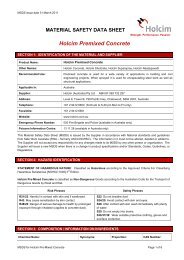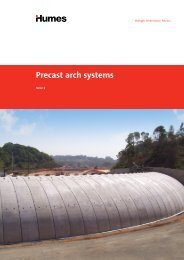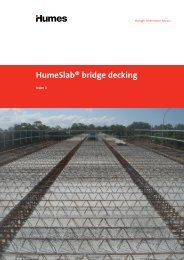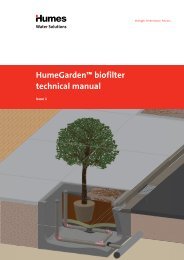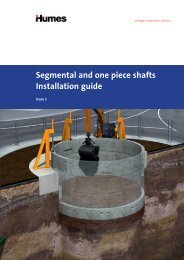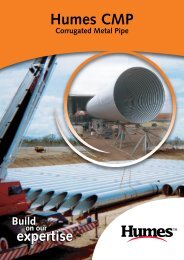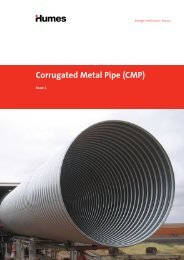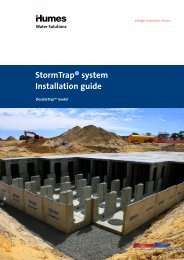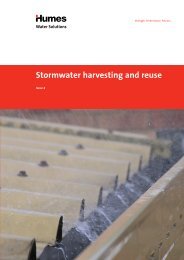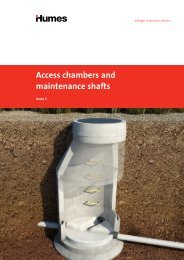Plastiline™ - Humes
Plastiline™ - Humes
Plastiline™ - Humes
You also want an ePaper? Increase the reach of your titles
YUMPU automatically turns print PDFs into web optimized ePapers that Google loves.
1 Composition<br />
1.1 All Plastiline sheet (keyed and plain) and all<br />
accessories shall be composed of high molar mass polyvinyl<br />
chloride combined with plasticisers, stabilisers and<br />
pigments compounded to make permanently flexible<br />
sheets. Copolymer resins shall not be permitted and<br />
polyvinyl chloride shall constitute not less than 99% by<br />
mass of the resin used.<br />
2 Manufacture<br />
2.1 Manufacture of sheet and accessories<br />
2.1.1 All Plastiline sheet and accessories shall be<br />
produced by extrusion or injection moulding under<br />
controlled temperature and pressure conditions. Keyed<br />
sheets shall be produced by extruding the key integrally<br />
with the sheet and using the same material as the sheet.<br />
2.1.2 During manufacture every sheet produced from a<br />
‘batch’ of compound shall be permanently marked with the<br />
batch identification. The sheet shall be 100% spark tested<br />
for continuity, using spark testing equipment which<br />
generates a minimum of 10,000 volts.<br />
2.2 Fabrication of blankets<br />
2.2.1 Blankets shall be fabricated from individual sheets or<br />
part sheets using automatic hot air welders.<br />
2.2.2 The joints shall be formed by lap welding sheets<br />
parallel to the keys, with a lap not less than 20mm and<br />
a weld width not less than 14mm.<br />
2.2.3 All joints shall be probe tested in accordance with<br />
clause 11.2. The tensile strength of samples taken from the<br />
joint and tested transverse to the joint shall be not less than<br />
20 N/mm.<br />
2.2.4 If a field joint type P2 (see page 11) is required,<br />
it shall be provided by the use of a special sheet (see<br />
page 3) with its wider flap when fabricating the blanket.<br />
2.2.5 Where the required blanket dimensions cannot be<br />
obtained by welding selected material parallel to the key,<br />
the alternatives are to either:<br />
(a) remove keys to form a 50mm wide flat section on<br />
each sheet, lap the sheets and weld as described in 2.2.2<br />
or<br />
(b)<br />
SPECIFICATIONS<br />
butt the sheets and weld strip on the smooth side of<br />
the sheets. This procedure is not recommended except in<br />
factory conditions when adequate support and alignment<br />
of the abutting edges can be ensured.<br />
3 Dimensions<br />
3.1 Sheet dimensions for both standard and special keyed<br />
sheets are given on page 3.<br />
3.2 The mass of the standard sheet (1240mm wide) per<br />
metre run shall be not less than 3.3 kg for keyed sheet.<br />
3.3 Blanket dimensions can be tailored to suit any<br />
installation purpose - the size limitation is in handling.<br />
Requirements should be discussed with your local <strong>Humes</strong><br />
representative.<br />
4 Chemical properties<br />
4.1 Using the test method of ASTM D 543 the change in<br />
mass of Plastiline when exposed to the chemicals<br />
listed below shall be determined.<br />
Specimens of identical area and with keys in identical<br />
positions shall be used in all tests. The change in mass shall<br />
not exceed the percentage shown. Sample size shall be<br />
75mm x 25mm by thickness of sheet.<br />
Chemical Agent<br />
Sodium Hypochlorite 0.20<br />
(1% as available chlorine)<br />
Ferric Chloride 1% 0.60<br />
Sodium Chloride 5% 0.15<br />
Sulfuric Acid 20% 0.12<br />
Nitric Acid 1% 0.20<br />
Sodium Hydroxide 5% 0.20<br />
Ammonium Hydroxide 5% 0.40<br />
Soap, Detergent Solution 2% 0.40<br />
5 Physical properties<br />
Maximum % change in mass of<br />
Plastiline over 7 days at 20°C<br />
5.1 The Plastiline shall meet the requirements<br />
stipulated herein and test certificates can be supplied<br />
if requested.<br />
Physical Property Test Method Acceptable Limits<br />
Tensile Strength<br />
(both longitudinal<br />
and transverse to key)<br />
Elongation at Break<br />
(both longitudinal and<br />
transverse to key)<br />
Hardness<br />
Plasticiser Permanence<br />
(24 hours at 90 O C on<br />
50mm diam. disc)<br />
Water Absorption at<br />
24 hours (sample size<br />
76mm x 25mm by<br />
thickness of sheet)<br />
Water Soluble<br />
matter at 24 hours<br />
Tear Strength (both<br />
longitudinal and<br />
transverse to key)<br />
ASTM D 412<br />
ASTM D 412<br />
Shore durometer<br />
D at 23 O C<br />
ASTM D 1203<br />
Method B<br />
ASTM D 570<br />
ASTM D 570<br />
ASTM D 1004<br />
(Grip Speed 8.5<br />
mm/s)<br />
17.25 MPa min.<br />
225% min.<br />
54 min. - 62 max.<br />
1.0% max.<br />
0.10% max.<br />
0.05% max.<br />
80 N/mm<br />
minimum<br />
9



